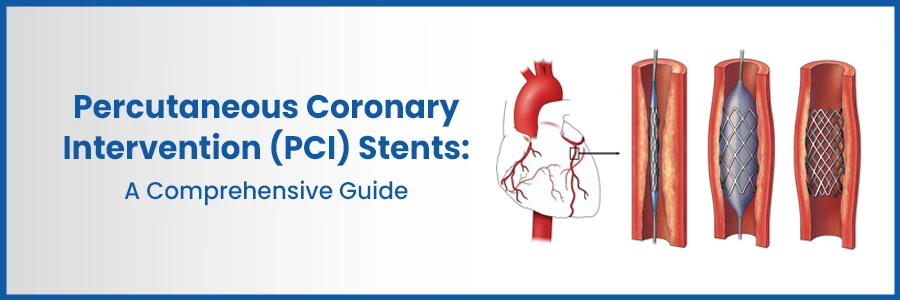Percutaneous Coronary Intervention (PCI) Stents: A Comprehensive Guide

Percutaneous coronary intervention (PCI), commonly known as coronary angioplasty, is a minimally invasive procedure used to open narrowed or blocked coronary arteries, the blood vessels that supply oxygen and nutrients to the heart muscle. This procedure is often performed to relieve symptoms such as chest pain (angina) and shortness of breath, and to reduce the risk of heart attack and stroke.
What is a PCI Stent
A PCI stent is a small, expandable metal tube that is placed inside a narrowed or blocked coronary artery to keep it open. Stents are typically made of stainless steel, cobalt-chromium, or nickel-titanium, and they come in various sizes and lengths to fit the individual needs of each patient.
Types of PCI Stents
There are two main types of PCI stents:
Bare-metal stents:
These stents are made of a metal mesh that expands to keep the artery open. Bare-metal stents are effective at widening narrowed arteries, but they carry a higher risk of restenosis, which is the narrowing of the artery again after it has been opened.
Drug-eluting stents:
These stents release a medication that helps to reduce the risk of restenosis. Drug-eluting stents are typically recommended for patients at higher risk of restenosis, such as those with diabetes or who have previously had a stent placed in the same artery.
Bioresorbable Vascular Scaffolds (BVS):
BVS are stents that gradually dissolve over time. They offer a temporary support structure before being fully absorbed by the body.
Who Should Get PCI Stents
PCI stents are not suitable for everyone. Your doctor will consider your individual risk factors, such as your age, overall health, and severity of coronary artery disease, to determine if PCI stents are right for you.
PCI stents are generally recommended for people who have:
- Significant narrowing or blockage of one or more coronary arteries
- Symptoms of coronary artery disease, such as chest pain, shortness of breath, or fatigue
- A history of heart attack or stroke
- Other risk factors for coronary artery disease, such as high blood pressure, high cholesterol, or diabetes
Who Should Not Have PCI Stents
While PCI stents are effective for many patients, there are certain cases where alternative treatments might be considered. PCI stents may not be suitable for people with the following conditions:
- Active bleeding
- Severe bleeding disorders
- Severe allergies to contrast dye or the stent material
- Pregnancy
- Untreated or poorly controlled high blood pressure
- Recent heart attack or stroke
Procedure Details
A PCI stent procedure typically involves the following steps:
Preparation:
The patient will be asked to remove any jewelry or piercings and may be given medication to help them relax.
Catheter insertion:
A catheter, a thin, flexible tube, is inserted into an artery in the groin or wrist.
Guidewire insertion:
A guidewire is passed through the catheter to the narrowed or blocked artery.
Balloon inflation:
A balloon is inflated at the tip of the guidewire to widen the narrowed artery.
Stent placement:
The stent is positioned over the narrowed artery and expanded to keep it open.
Catheter removal:
The balloon and guidewire are removed, and the catheter is withdrawn from the artery.
Closure of the insertion site:
The insertion site is closed with a small incision or bandage.
The entire procedure usually takes about an hour. After the procedure, the patient will be monitored for several hours to ensure there are no complications. Most people are able to go home the same day of the procedure.
Before Percutaneous Coronary Intervention Stent:
Before a PCI stent procedure, the patient will need to:
- Pre-procedure assessments include a thorough medical history review and diagnostic tests such as angiograms.
- Patients may be advised to stop certain medications such as blood thinners or fast before the procedure.
During Percutaneous Coronary Intervention Stent
During a PCI stent procedure, the patient will:
- Receive local anesthesia at the insertion site.
- The patient is usually awake but sedated throughout the procedure.
- A catheter with a deflated balloon and stent is guided to the blocked artery.
- The balloon is inflated to compress the plaque, and the stent is deployed to keep the artery open.
- The procedure typically takes about 30 to 60 minutes.
Benefits of PCI Stents
PCI stents offer several benefits, including:
- Improved blood flow to the heart
- Reduced symptoms of coronary artery disease
- Reduced risk of heart attack and stroke
- Minimally invasive procedure
- Shorter recovery time
Risks of PCI Stents
PCI stents also carry some potential risks, including:
- Bleeding
- Infection
- Blood clot formation
- Damage to the artery
- Restenosis
Living with PCI Stents
After you have had PCI stents, you will need to take medications to reduce the risk of blood clots forming on the stents. You may also need to make some lifestyle changes, such as quitting smoking, eating a healthy diet, and exercising regularly.
You will also need to see your doctor for regular follow-up appointments. These appointments are important to monitor your progress and make sure that your stents are working properly.
With proper care, you can live a long and healthy life with PCI stents.